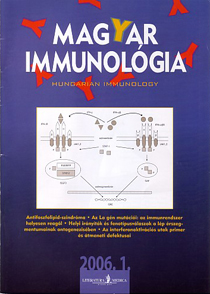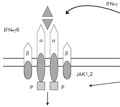The eLitMed.hu medical portal uses computer cookies for convenient operation. Detailed information can be found in the Cookie-policy.
Hungarian Immunology - 2006;5(01)
Content
[Antiphospholipid syndrome - focused on the childhood form]
[Antiphospholipid syndrome is an autoimmune disorder characterized by recurrent thromboembolic events with concurrent presence of antiphospholipid antibodies in the sera. The morbidity and mortality of the syndrome is defined by the clinical manifestations: deep vein thrombosis, cerebrovascular events, myocardial infarct, pulmonary embolism, recurrent pregnancy losses and prematurity. The authors reviewed the pathogenesis, the clinical course and the treatment of the antiphospholipid syndrome focused on the childhood form.]
[Mutations of La gene: the proper reaction of the immune system]
[Numerous hypotheses have emerged to solve the problem and the pathomechanism of autoimmunity so far. Different factors are suspected, from viruses to neuroendocrine elements, to be a pathogen in the etiology of autoimmune diseases. Most of the theories are based on the assumption that something happens to the immune system and it leads to an autoimmune reaction against the proper self. This paper indicates that, at least in certain cases, the immune system reacts properly against the altered cells; therefore the cause of the autoimmunity lies in the other improper functioning of the body. Experimental data show that La autoantigen plays a role not only as a diagnostic marker but it may participate in the pathomechanism of certain autoimmune diseases as well. Mutations in the exon 7 of La gene have such consequences that could lead to the formation of autoimmune reactions detected.]
[Regional cues and phenotypic responses during the ontogeny and postnatal development of splenic vasculatur]
[Among structured peripheral lymphoid tissues in man and rodents, the spleen demonstrates the most extensive flexibility in functional activities, which is coupled with considerable tissue architecture adjustments during ontogeny and immune reactions. The sequential conversion of a primary lymphohemopoietic tissue into a major peripheral lymphoid organ (while participating in the post-myeloid period of primary B-lymphopoiesis and retaining the potential for myelopoiesis) is accompanied with the ordered segregation involving various non-hemopoietic components of architecture, including the endothelia of blood vessels. In this report we will survey the functional and structural aspects of heterogeneous endothelial cells lining the various splenic vascular beds, comprising the complex circulatory network of the spleen. These features will be correlated with the characteristics of those regulatory mechanisms that have recently been demonstrated to be responsible for the establishment and maintenance of the endothelial divergence during splenic vascular development, including crucial transcription factors, morphogenic regulatory ligands and receptors of the tumor necrosis factor/lymphotoxin (TNF/LT) family and others. The influence of these regulatory elements in mice appears to be highly restricted in terms of regional involvement of the vasculature, with cellular alterations of the marginal sinus representing the most frequently affected region. This complexity highlights the importance of this tissue region in both the formation of splenic vasculature and a possible source for white pulp stromal elements as well as its function as a major gateway for lymphocyte traffic.]
1.
Clinical Neuroscience
[Headache registry in Szeged: Experiences regarding to migraine patients]2.
Clinical Neuroscience
[The new target population of stroke awareness campaign: Kindergarten students ]3.
Clinical Neuroscience
Is there any difference in mortality rates of atrial fibrillation detected before or after ischemic stroke?4.
Clinical Neuroscience
Factors influencing the level of stigma in Parkinson’s disease in western Turkey5.
Clinical Neuroscience
[The effects of demographic and clinical factors on the severity of poststroke aphasia]1.
2.
3.
4.
5.







